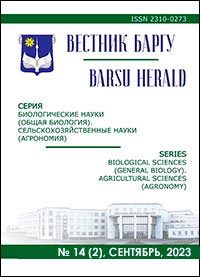TRUE BUGS (HEMIPTERA: HETEROPTERA) OF NON-OVERGROWING AREAS OFNON-FLOODPLAIN FALLOW MEADOWS OF BEREZINSKY BIOSPHERE RESERVE
Keywords:
true bugs; Heteroptera; non-floodplain fallow meadows; Berezinsky biosphere reserve; BelarusAbstract
Dry meadows are classified as non-floodplain and a component of the natural complex of the Berezinsky
Biosphere Reserve and make up about 11 % of its territory. One of the main tasks of the reserve is to preserve the
biological diversity of its territory, the core of which is insects. The fallow meadows excluded from use are overgrown
with trees and shrubs, and a change in the structure of the phytocenosis also causes the transformation of
entomocomplexes consortively associated with vegetation. In the result of studies conducted by standard methods in
2021—2022 years, 126 species of true hemipteran insects (Hemiptera: Heteroptera) from 88 genera of the 21st family
were identified in five non-overgrowing areas of non-floodplain fallow meadows of the Berezinsky Biosphere Reserve.
In terms of the number of species in the established heteropterofauna of open areas of non-floodplain fallow meadows,
bed bugs (family Miridae) dominate — 47 species, 37 %. At the generic level, the maximum number of bug species was
found for the genus Nabis (family Nabidae) — 5. The maximum number of species was recorded in an open area in
a grass-forb association of a fallow meadow in the environs of the village Sloboda — 73 species (58 % of the bug species registration areas, was found in the following representatives of true bugs: Tingis crispatа (Herrich-Schaeffer, 1838),
Lygus pratensis (Linnaeus, 1758), Notostira elongata (Geoffroy, 1785), Stenodema calcarata (Fallén, 1807), Nabis
brevis Scholtz, 1847, Coreus marginatus (Linnaeus, 1758), Aelia acuminate (Linnaeus, 1758), Carpocoris
purpureipennis (De Geer, 1773) and Dolycoris baccarum (Linnaeus, 1758). The maximum values of the indices of
biological diversity of the heteropterofauna of meadows in the environs vill. Sloboda, Zalkhovye and Kadlubishche
testify to their stable state. The heteropterofauna of the non-overgrown fallow meadows of the reserve is characterized by
significant originality, only for two pairs of compared sites the community index (Chekanovsky-Sørensen) turned out to
be higher than 50 %. Perhaps this is due to the short period of research — only two seasons, as well as differences in the
floristic composition of open grass communities, their genesis and dynamics (seasonal and long-term).
Table 1. Ref.: 12 titles.
Published
Issue
Section
License
Copyright (c) 2023 Вестник БарГУ Серия "Биологические науки. Сельскохозяйственные науки"
Это произведение доступно по лицензии Creative Commons «Attribution-NonCommercial» («Атрибуция — Некоммерческое использование») 4.0 Всемирная.
Авторы сохраняют за собой право заключать определенные договорные соглашения, касающиеся неисключительного распространения опубликованной версии работы (например, размещать ее в институциональном репозитории, публикация в книге) со ссылкой на ее первоначальную публикацию в этом журнале.





